Readings Newsletter
Become a Readings Member to make your shopping experience even easier.
Sign in or sign up for free!
You’re not far away from qualifying for FREE standard shipping within Australia
You’ve qualified for FREE standard shipping within Australia
The cart is loading…






This timely volume brings together various issues in Muslim consumer cultures and provides a comprehensive account of Muslim tourism and tourist behaviour.
Islam is a major international religion and Muslims are a majority of the population in many countries in Asia, the Middle East and North Africa. The growth of a substantial middle class, the development of Islamic consumer cultures, rising Muslim market consumption in non-Muslim majority destinations and the growing significance of intra-Muslim traffic and rising outbound tourism expenditure in emerging Muslim markets have all contributed to substantial interest in Muslim tourism. However, travel by Muslims is about far more than the Hajj and Umrah, as important as they are as acts of devotion. Instead, although often portrayed in the West as a monolithic religion, Muslim travel and leisure behaviour is very diverse, with different traditions and cultures leading to a range of expressions of tourism-related consumption culture and practices. Drawing on a range of empirical studies undertaken in different social and economic contexts and countries, this book provides a well-balanced portrayal of the Muslim tourism experience and practices.
This book makes a substantial contribution to an improved understanding of Muslim travel culture and will be required reading for anyone interested in this fast-growing market.
$9.00 standard shipping within Australia
FREE standard shipping within Australia for orders over $100.00
Express & International shipping calculated at checkout
This timely volume brings together various issues in Muslim consumer cultures and provides a comprehensive account of Muslim tourism and tourist behaviour.
Islam is a major international religion and Muslims are a majority of the population in many countries in Asia, the Middle East and North Africa. The growth of a substantial middle class, the development of Islamic consumer cultures, rising Muslim market consumption in non-Muslim majority destinations and the growing significance of intra-Muslim traffic and rising outbound tourism expenditure in emerging Muslim markets have all contributed to substantial interest in Muslim tourism. However, travel by Muslims is about far more than the Hajj and Umrah, as important as they are as acts of devotion. Instead, although often portrayed in the West as a monolithic religion, Muslim travel and leisure behaviour is very diverse, with different traditions and cultures leading to a range of expressions of tourism-related consumption culture and practices. Drawing on a range of empirical studies undertaken in different social and economic contexts and countries, this book provides a well-balanced portrayal of the Muslim tourism experience and practices.
This book makes a substantial contribution to an improved understanding of Muslim travel culture and will be required reading for anyone interested in this fast-growing market.